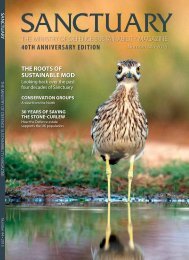SUSTAINABILITY
UBUt5
UBUt5
You also want an ePaper? Increase the reach of your titles
YUMPU automatically turns print PDFs into web optimized ePapers that Google loves.
AROUND THE REGIONS<br />
22<br />
North Yorkshire<br />
RAF Fylingdales<br />
The cuckoo Vigilamus © Scott Wicking<br />
A number of cuckoos ‘stationed’ at<br />
RAF Fylingdales, have been fitted<br />
with satellite tracking devices by the<br />
British Trust for Ornithology (BTO), in<br />
an effort to monitor their migration<br />
and track their activity. Using this<br />
advanced technology, satellites will<br />
detect the trackers on the back of the<br />
cuckoos which in turn will provide this<br />
important information on migration<br />
and bird activity to the trust.<br />
essence it will track the satellites which<br />
in turn track the transmitters located<br />
on the bird’s backs, providing the trust<br />
with detailed flight patterns of their<br />
day to day exploits.<br />
The project is led by BTO scientist Dr<br />
Chris Hewson, who said: “If we are to<br />
produce a conservation strategy for a<br />
bird like the cuckoo that spends most<br />
of its time outside of the UK, we need to<br />
understand its full life cycle. Without this<br />
it would be like doing a jigsaw with some<br />
of the pieces missing. With the help of<br />
RAF Fylingdales, we hope to find some of<br />
those missing pieces.<br />
“Right now we want to know whether<br />
the migration routes of birds in the north<br />
east differ from those in other parts of<br />
the UK RAF Fylingdales still has a healthy<br />
population of cuckoos and what they do<br />
once they leave for the winter could give<br />
us important information that will help<br />
inform cuckoo conservation across the UK.”<br />
Whilst carrying out the tagging of<br />
the cuckoos, Mick Carroll, a long<br />
time Fylingdales conservation<br />
group volunteer, enquired about<br />
the possibility of one of the tagged<br />
cuckoos being named ‘Vigilamus’ af ter<br />
the station motto ‘We are watching’.<br />
BTO kindly agreed to the request<br />
and a tagged male adult cuckoo was<br />
named Vigilamus at RAF Fylingdales<br />
on 20th May 2015.<br />
Tagged cuckoos can be tracked to<br />
their location via the BTO website.<br />
Information received via the satellite<br />
tracking system showed Vigilamus<br />
had arrived in Africa at the end of<br />
July 2015.<br />
Kevin Phillips CMIOSH, MIIRSM<br />
Station Safety & Environment Advisor<br />
Carolyn Keeble<br />
Safety & Environment Clerk<br />
RAF Fylingdales<br />
The last 25 years have seen a<br />
significant decline of almost 75% in<br />
the number of breeding cuckoos,<br />
predominantly in the south east of<br />
Britain. Whilst some data is currently<br />
available on cuckoos while they are<br />
here in the UK these tracking devices<br />
should hopefully provide organisations<br />
like the BTO with a valuable insight into<br />
the cuckoo’s habits over the winter<br />
months and shed some light onto the<br />
reason for their decline.<br />
RAF Fylingdales has a big part to<br />
play in the success of the project. In<br />
The team with Mick Carroll (right) and Vigilamus © Scott Wicking<br />
Sanctuary 44 • 2015 95



